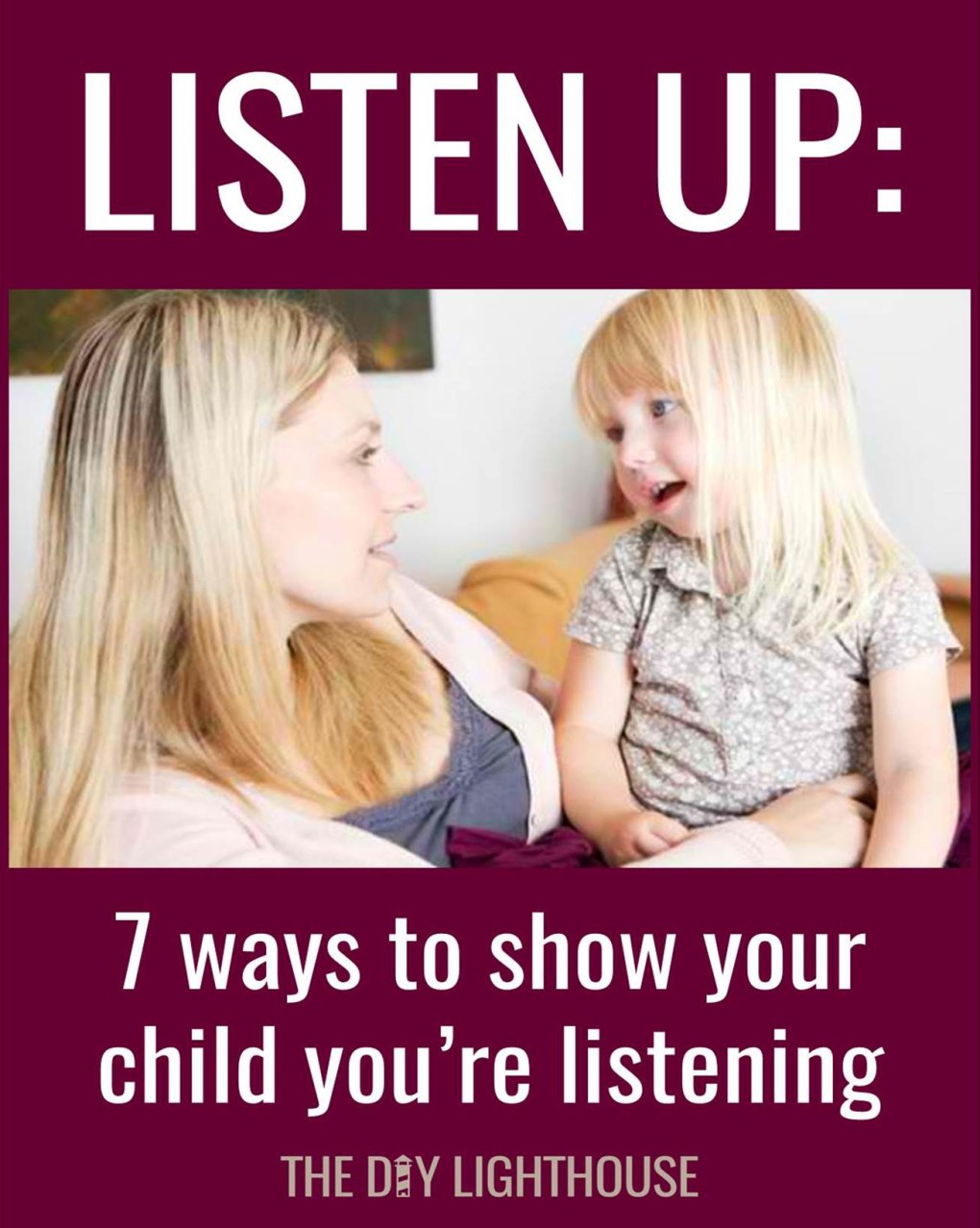Because communication is a crucial relationship building block, it’s important to show your child you are listening. As you listen to them, the trust between you will strengthen, and your child will begin to see you more as an ally, someone who they can confide in. Your child will bring up difficult topics, like bullying, much earlier if they feel that trust. (Read about the 10 Signs Your Child is Being Bullied at School.) Really listening to your child can be hard, especially if you feel your relationship is somewhat strained. By implementing and practicing these 7 listening habits, your child will know that you are truly listening.
*Affiliate disclaimer: We include affiliate links for products within this post that we recommend. This means we get a commission if you choose to purchase something we refer to.
1. You acknowledge them
The first step to listening comes at the boundary moment when they first walk into the room or get in the car: acknowledging them. Recognize that your child is there and that you value them by saying hi, smiling at them, and calling them by name. Names are powerful, so use them. One thing you could say is, “Hi John! I missed you today.” It doesn’t have to be long or over the top to make a huge difference. When you respond to their presence, your child will feel recognized, accepted, and valued. These feelings will naturally put them at ease, and they will more likely communicate with you.
2. You engage body language
When your child does open up and talk to you, it’s important to physically show your child you are listening through proper body language. Directly turn your body to face them, occasionally nod your head, look into their eyes when they speak, and show appropriate facial emotion. Make sure you’re not just giving outward signs of listening, but that you also focus your mind on what they are saying. It’s amazing how your body language will more naturally respond to what your mind is focused on: your child.
If you want to be able to better read your child, be sure to check out what a body language expert and former FBI agent is saying. Be sure to read his book, “What Every Body is Saying: An Ex-FBI Agent’s Guide to Speed-Reading People” (*affiliate link). This book will help you decode behaviors that you otherwise might not notice or be able to interpret.
3. You put away technology
As explained with body language, if your eyes and hands are on your electronic devices, it’s a sign you’re not really listening. Put down the phone and close the laptop. You could even have a designated tech basket (like this modern metal wall hanging basket! *affiliate disclaimer) where you place your handheld electronic devices during opportune listening moments, such as when your child first comes home from school or wakes up from a nap. By putting away technology while your child is talking, you are showing them that you value their thoughts and feelings more than work, social media, or your selfie. Realize your priority and live by it.
4. You seek to recognize, not fix
Rather than try to always fix your child’s problems, seek to just recognize what they’re going through. Giving advice is sometimes helpful, but other times it’s best to just listen. Letting your child work through their problems on their own allows your child to express themselves and review their thoughts. By jumping in with a quick solution, your child may feel their concern has been downplayed. Show your child you are listening, not fixing.
5. You show empathy
When it comes to listening to your child, empathy is better than sympathy. Empathy is the ability to understand and share in the feeling of another, not just showing pity for their sadness. Sensing your child’s emotion in what they are saying while trying to see the situation from their point of view is being empathetic. Sympathy says, “That’s too bad but it could be worse,” or, “I’m sorry that happened, but that’s really nothing compared to what I went through when I was your age.” Sympathy tries to quickly lighten the mood. Remember, when trying to connect with a child through listening, it’s not about you; it’s about them. Show empathy by matching the mood of your child and being okay with moving at their emotional pace. Empathy is saying, “Wow, I don’t even know what to say right now. That must be so hard.” Click out this great video The RSA published that explains, in detail, the difference between empathy and sympathy: Brene Brown on Empathy – YouTube.
6. You ask appropriate questions
Asking the right questions at the right time is crucial to your child feeling heard and valued. If you must, ask clarifying questions along the way, but be careful not to interrupt. Clarifying questions are simple questions of facts. An example of a clarifying questions would be, “When you said….what did you mean?” Through seeking to understand, you show your child you really care about what they are saying and that you’re interested in them.
When they are finished talking, ask an open-ended question that requires more than a “yes” or “no” answer. Open-ended questions help your child figure out their underlying feelings and their deeper thoughts on the matter. An example of an open-ended question is, “How did that make you feel?” These questions typically start with “how” and the 5 W’s: who, what, where, why, and when. Appropriate questions asked at the right time can show your child you are listening and want to know more.
7. You talk with them
As a parent, sometimes it’s hard to remember that we should not talk to our child or talk over them. Hogging the speaking time and interrupting what your child is saying may make them feel that what they are saying is unimportant to you. It’s so critical to talk with your child. If your child is speaking the majority of the time, that is a good indication that they are getting their fair share of the conversation. Show you care by not being too anxious to get your own words across.
Listening is a talent that can be developed, and it’s an important one to cultivate as a parent. After implementing and practicing these positive listening techniques, your relationship with your child will strengthen. And as a result, your child will feel more loved, valued, and heard.
Please feel free to comment below with others ways that show your child you are listening.




